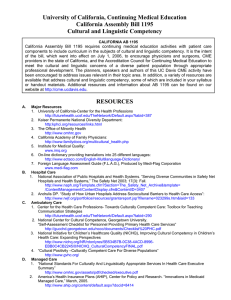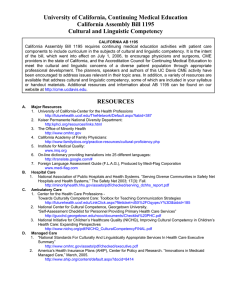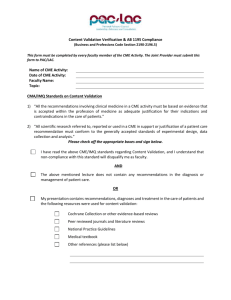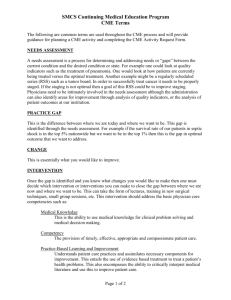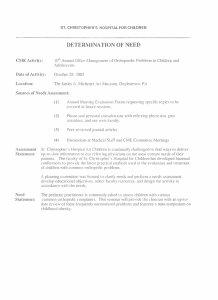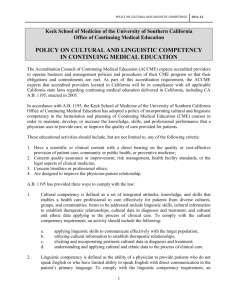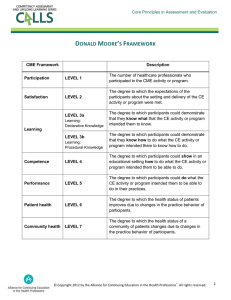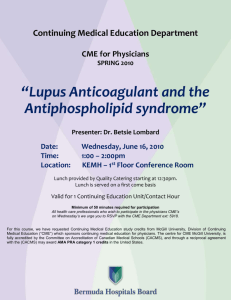EDUCATIONAL MANDATES FOR CALIFORNIA PHYSICIANS
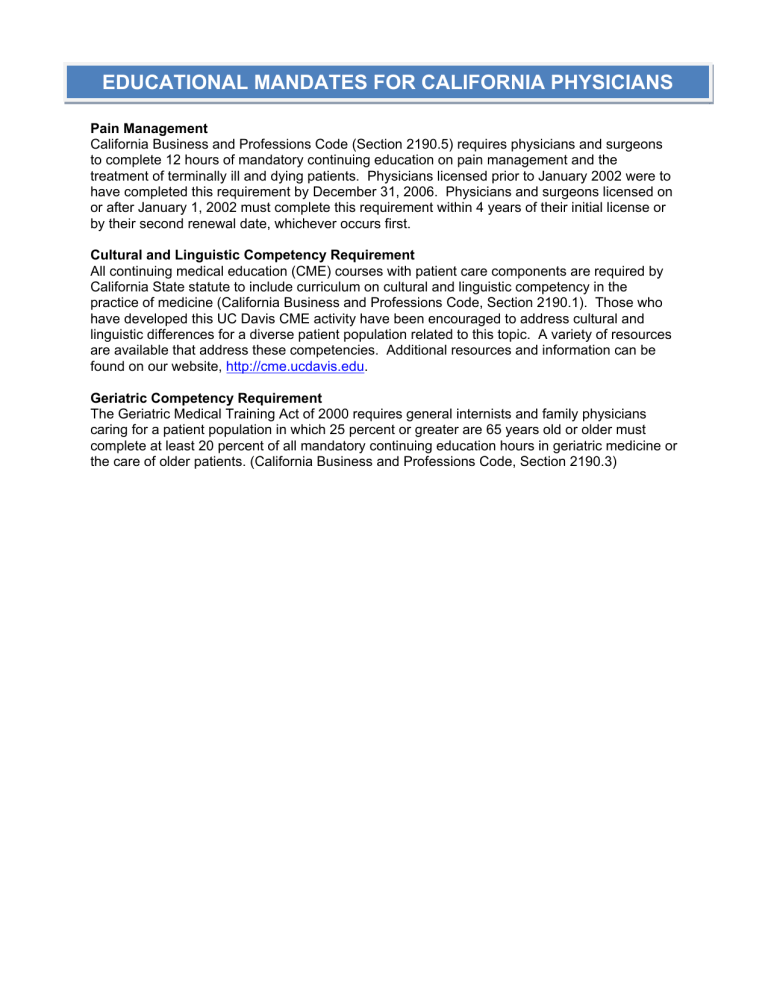
EDUCATIONAL MANDATES FOR CALIFORNIA PHYSICIANS
Pain Management
California Business and Professions Code (Section 2190.5) requires physicians and surgeons to complete 12 hours of mandatory continuing education on pain management and the treatment of terminally ill and dying patients. Physicians licensed prior to January 2002 were to have completed this requirement by December 31, 2006. Physicians and surgeons licensed on or after January 1, 2002 must complete this requirement within 4 years of their initial license or by their second renewal date, whichever occurs first.
Cultural and Linguistic Competency Requirement
All continuing medical education (CME) courses with patient care components are required by
California State statute to include curriculum on cultural and linguistic competency in the practice of medicine (California Business and Professions Code, Section 2190.1). Those who have developed this UC Davis CME activity have been encouraged to address cultural and linguistic differences for a diverse patient population related to this topic. A variety of resources are available that address these competencies. Additional resources and information can be found on our website, http://cme.ucdavis.edu
.
Geriatric Competency Requirement
The Geriatric Medical Training Act of 2000 requires general internists and family physicians caring for a patient population in which 25 percent or greater are 65 years old or older must complete at least 20 percent of all mandatory continuing education hours in geriatric medicine or the care of older patients. (California Business and Professions Code, Section 2190.3)
University of California, Continuing Medical Education
California Assembly Bill 1195 Cultural and Linguistic Competency
RESOURCES
A. Major Resources
1. University of California-Center for the Health Professions http://futurehealth.ucsf.edu/TheNetwork/Default.aspx?tabid=387
2. Kaiser Permanente National Diversity Department: http:kphci.org/resources/links.html
3. The Office of Minority Health http://www.omhrc.gov
4. California Academy of Family Physicians: http://www.familydocs.org/multicultural_health.php
5. Institute for Medical Quality: www.imq.org
6. On-line dictionary providing translations into 25 different languages: http://www.ectaco.com/English-Multilanguage-Dictionary/
7. Foreign Language Assessment Guide (F.L.A.G.), Produced by Medi-Flag Corporation www.medi-flag.com
B. Hospital Care
1. National Association of Public Hospitals and Health Systems. “Serving Diverse
Communities in Safety Net
Hospitals and Health Systems,” The Safety Net 2003; 17(3): Fall. http://www.naph.org/Template.cfm?Section=The_Safety_Net_Archive&template=
/ContentManagement/ContentDisplay.cfm&ContentID=3407
2. Andrulis DP. “Study of How Urban Hospitals Address Sociocultural Barriers to Health
Care Access”: http://www.rwjf.org/portfolios/resources/grantsreport.jsp?filename=023299s.htm&iaid=13
C. Ambulatory Care
1. Center for the Health Care Professions- Towards Culturally Competent Care: Toolbox for Teaching Communication Strategies http://futurehealth.ucsf.edu/TheNetwork/Default.aspx?tabid=290
2. National Center for Cultural Competence, Georgetown University.
“Self-Assessment Checklist for Personnel Providing Primary Health Care Services” http://gucchd.georgetown.edu/nccc/documents/Checklist%20PHC.pdf
3. National Initiative for Children’s Healthcare Quality (NICHQ), Improving Cultural
Competency in Children’s Health Care: Expanding Perspectives http://www.nichq.org/NR/rdonlyres/5B534B7B-0C38-4ACD-8996-
EBB0C4CB2245/0/NICHQ_CulturalCompetencyFINAL.pdf
4. “Cultural Positivity –Culturally Competent Care For Diverse Populations” http://www.gvhc.org/
D. Managed Care
1. “National Standards For Culturally And Linguistically Appropriate Services In Health
Care Executive Summary” http://www.omhrc.gov/assets/pdf/checked/executive.pdf
2. America’s Health Insurance Plans (AHIP), Center for Policy and Research. “Innovations in Medicaid Managed Care,” March, 2005. http://www.ahip.org/content/default.aspx?docid=8414
CALIFORNIA AB 1195
California Assembly Bill 1195 requires continuing medical education activities with patient care components to include curriculum in the subjects of cultural and linguistic competency. It is the intent of the bill, which went into effect on July 1, 2006, to encourage physicians and surgeons,
CME providers in the state of California, and the Accreditation Council for Continuing Medical
Education to meet the cultural and linguistic concerns of a diverse patient population through appropriate professional development. The planners, speakers and authors of this UC Davis
CME activity have been encouraged to address issues relevant in their topic area. In addition, a variety of resources are available that address cultural and linguistic competency, some of which are included in your syllabus or handout materials. Additional resources and information about AB 1195 can be found on our website at http://cme.ucdavis.edu.
E. Caring for Individuals with Limited English Proficiency
1. Center for the Health Professions-Common Sentences in Multiple Languages (ICE) Tool for Office Staff http://futurehealth.ucsf.edu/TheNetwork/Portals/3/CommonSentences.pdf
2. National Council on Interpreting in Health Care http://www.ncihc.org
3. Addressing Language Access in Your Practice Toolkit California Academy of Family
Physicians http://www.familydocs.org/multicultural_health.php
4. Hablamos Juntos: Improving Patient-Provider Communication for Latinos http://www.hablamosjuntos.org
5. Process of Inquiry: Communicating in a Multicultural Environment, Georgetown
University National Center for Cultural Competence http://www.nccccurricula.info/
6. Cross-Cultural Communication in Health Care: Building Organizational Capacity http://www.hrsa.gov/reimbursement/broadcast/default.htm
F. Health Literacy
1. AMA/AMA Foundation’s Health Literacy toolkits, videos, partnerships http://www.ama-assn.org/ama/pub/category/8115.html
2. Weiss BD. Health Literacy: A Manual for Clinicians Chicago: American Medical
Association Foundation, 2003
3. Schwartzberg, JG, VanGeest JB, Wang CC: Understanding Health Literacy: Implications for Medicine and Public Health. Chicago, IL: American Medical Association Pres., 2004
G. Movies, Videos, and CD-ROM Resources
1. Alexander M. Cinemeducation: An Innovative Approach to Teaching Multi-Cultural
Diversity in Medicine. Annals of Behavioral Science and Medical Education 1995;
2(1):23-28.
2. Communicating Effectively Through an Interpreter (1998) (Available from the Cross
Cultural Health Care Program, 270 South Hanford Street, Suite 100, Seattle,
Washington 98134; Phone (206)-860-0329;
Website http://www.xculture.org
3. The Bilingual Medical Interview I (1987), and The Bilingual Medical Interview II: The
Geriatric Interview, Section of General Internal Medicine, Boston City Hospital, in collaboration with the Department of Interpreter Services and the Boston Area Health
Education Center (Available from the BAHEC, 818 Harrison Ave., Boston, MA 02118;
Phone (617)-534-5258).
4. The Kaiser Permanente/California Endowment Clinical Cultural Competency Video
Series . In 2000, Kaiser Permanente, with funding from The California Endowment, embarked on a project to create "trigger" videos as teaching tools for training healthcare professionals in cultural competence.. These now completed videos comprise three sets, each with accompanying facilitator's guide and contextual materials. Each set costs
$35.00 or $105 for all 20. The scenarios are from eight to fourteen minutes long.
5. Quality Care for Diverse Populations . Video/CD-ROM/Facilitator's Guide, Contributors:
K. Bullock, L.G. Epstein, E.L. Lewis, R.C. Like, J.E. South Paul, C. Stroebel, et al.) This educational program includes five video vignettes depicting simulated physician-patient visits in an office setting as a means to explore ethnic and sociocultural issues found in today's diverse health care environment. Produced by the American Academy of Family
Physicians (AAFP), with partial funding by the Bureau of Primary Health Care, Health
Resources and Services Administration, June 2002. (Available from the American
Academy of Family Physicians, AAFP Order Dept., 11400 Tomahawk Creek Parkway,
Leawood, KS 66211; Phone (800)-944-0000; Fax (913)-906-6075; http://www.aafp.org/x13887.xml
6. Community Voices: Exploring Cross-Cultural Care Through Cancer . Video and
Facilitator's Guide by Jennie Greene, MS & Kim Newell, MD (Available from the Harvard
Center for Cancer Prevention, Harvard School of Public Health, 665 Huntington Avenue,
Bldg 2, Rm 105, Boston, MA 02115; Phone (617) 432-0038; Fax: (617)-432-1722; hccp@hsph.harvard.edu or Fanlight Productions. www.fanlight.com
7. Worlds Apart. A Four-Part Series on Cross-Cultural Healthcare. By Maren Grainger-
Monsen, MD, and Julia Haslett, Stanford University, Center for Biomedical Ethics
(available from Fanlight Productions, www.fanlight.com
8. The Angry Heart: The Impact of Racism on Heart Disease Among African Americans ,
Jay Fedigan. Available from Fanlight Productions. www.fanlight.com
9. The Culture of Emotions: A Cultural Competence and Diversity Training Program .
Harriet Koskoff, Producer/Co-Coordinator, 415 Noe Street, #5 , San Francisco , CA
94114 ; Phone 415-864-0927; Fax 415-621-8969 (Available from Fanlight Production. www.fanlight.com
10. Ohio Department of Health and Medical College of Ohio. Cultural Competence in Breast
Cancer
H. Continuing Education Programs
1. Office of Minority Health A Family Physician's Guide to Culturally Competent Care http://cccm.thinkculturalhealth.org
2. Quality Interactions: A Patient-Based Approach to Cross-Cultural Care Manhattan Cross
Cultural Group and Critical Measures http://www.criticalmeasures.net/cross_cultural/elearning.htm
3. Delivering Culturally Effective Care for Patients with Diabetes Medical Directions - The
Virtual Lecture Hall and Department of Family Medicine, University of Arizona College of
Medicine at the Arizona Health Sciences Center http://www.vlh.com/shared/courses/course_info.cfm?courseno=1786
4. Communicating Through Health Care Interpreters Medical Directions - The Virtual
Lecture Hall and Rush University Medical Center http://www.vlh.com/shared/courses/course_info.cfm?courseno=1705
5. Culture and Health Care: An E-Learning Course (based on Cultural Sensitivity:
A Guidebook for Physicians and HealthCare) Doctors in Touch (DIT) http://www.doctorsintouch.com/courses_for_CME_credit.htm
6. Quality Care for Diverse Populations . Video/CD-ROM/Facilitator's Guide, Contributors:
K. Bullock, L.G. Epstein, E.L. Lewis, R.C. Like, J.E. South Paul, C. Stroebel, et al.) This educational program includes five video vignettes depicting simulated physician-patient visits in an office setting as a means to explore ethnic and sociocultural issues found in today's diverse health care environment. Produced by the American Academy of Family
Physicians (AAFP), with partial funding by the Bureau of Primary Health Care, Health
Resources and Services Administration, June 2002. (Available from the American
Academy of Family Physicians, AAFP Order Dept., 11400 Tomahawk Creek Parkway,
Leawood, KS 66211; Phone (800)-944-0000; Fax (913)-906-6075. http://www.aafp.org/x13887.xml
7. Cultural Competency Challenge CD-ROM Educational Program (AAOS Product #02735).
American Academy of Orthopaedic Surgeons, 6300 North River Road, Rosemont, IL
60018-4262. www.aaos.org/challenge
8. Cross-Cultural Health Care: Case Studies Pediatric Pulmonary Centers: A Collaborative
Web Site of the MCH Training Network. http://ppc.mchtraining.net/custom_pages/national_ccce
9. Measuring Health Disparities, Interactive CD-ROM. John Lynch, PhD, and Sam Harper,
PhD, McGill University. Produced by the Michigan Public Health Training Center
(MPHTC). measuringhealthdisparities.org
I. Recent Articles and References on Cultural and Linguistic Competency
1. Brach C, Fraser I, and Paez K. “Crossing the Language Chasm,” Health Affairs 2005
(March); 24(2):424-434.
2. Betancourt, J.R., Green, A.R., Carillo, J.E. et al. (2005). Cultural competency and health care disparities: Key perspectives and trends. Health Affairs, 24(2), 499-505.
3. Brach, C., Fraser, I., Paez, K. (2005). Crossing the language chasm:An indepth analysis of what language-assistance programs look like in practice. Health Affairs, 24(2), 424-
434.
4. Betancourt J.R., Green A.R., Carrillo J.E., et al. (2003). Defining cultural competence:
A practical framework for addressing racial/ethnic disparities in health and health care.
Public Health Reports, 118(4), 293-302.
5. AB 801 Assembly Bill – Chaptered. Official California Legislative Information website. www.leginfo.ca.gov/pub/0304/bill/asm/ab_080160850/ab_801_bill_20030925_chaptered
.html (cited 7 Nov. 2005).
6. AB 1195 Assembly Bill – Chaptered. Official California Legislative Information website. www.leginfo.ca.gov/pub/bill/asm/ab_11511200/ab_1195_bill_20051004_chaptered.html
(cited 7 Nov. 2005).
7. Youdelman M, Perkins J. “Providing Language Interpretation Services in Health Care
Setting: Examples from the Field,” National Health Law Program, May 2002
8. Youdelman M, Perkins J. “Providing Language Services in Small Health Care Provider
Settings” Examples from the Field,” National Health Law Program, April 2005. The latter two reports can be obtained at: www.cmwf.org or www.healthlaw.org
Compiled by: The University of California, Continuing Medical Education Consortium,
University of California, Davis, University of California, Irvine, University of California, Los
Angeles, University of California, San Diego, and University of California, San Francisco.
For questions, please call Gwenn Welsch, UC Davis CME Website Coordinator at (916) 734-
5773 or email gwenn.welsch@ucdmc.ucdavis.edu Additional resources and information about
AB1195 can be found on our website at http://cme.ucdavis.edu.
